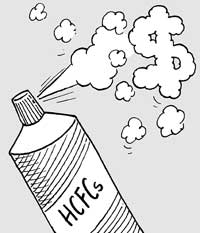Dubious substitutes
 Why should a convention, which wants to put an end to ozone depleting substances, instead promote their use? Because that's exactly what it does in the case of hydrochlorofluorocabons (HCFCs).
Why should a convention, which wants to put an end to ozone depleting substances, instead promote their use? Because that's exactly what it does in the case of hydrochlorofluorocabons (HCFCs).
HCFCs were accepted as interim substitute for CFCs on the basis of an assumption that they are less harmful to the ozone layer. The Montreal Protocol uses the ozone depleting potential (ODP) of a substance to grade its harmful nature. ODP measures the chemical's capacity to destroy ozone over 500 years. Using this measure, HCFCs have about 1-6 per cent of the destructive capability of CFCs. But according to Karen Clark from the World Wide Fund for Nature International, a more accurate measure is the chlorine loading potential (CLP) - a straightforward calculation of how much pollutant gets loaded in the air in short and medium terms. According to UK-based Stratospheric Ozone Review Group, the impact of HCFC-141b, in terms of CLP, after 10 years can be as high as 50 per cent that of CFC-11. The European Union claims that during the next 10-20 years HCFCs can contribute significantly more to the ozone depletion than is reflected in their ODP values.
Then why does the developing world, influenced by the protocol, spend so much on such harmful substances, which are supposed to be only a transition substitute?
The answer to the riddle lies in the business interests of multinationals like Du Pont, which was once one of the biggest producers of CFCs. It also produced HCFCs for years before the protocol was signed. The chemical giant turned the threat of the protocol's banning of CFCs to its advantage by promoting another range of its products as substitute. The result: The entire developing world is now shooting itself in the foot by replacing one ODS with another. By 2040 when these too are to be phased out, will the world again become a forced buyer of Du Pont's dubious wares?
